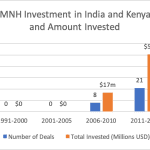Impact Investing Comes of Age: ImpactAlpha Rounds up Nine Stories Shaping the Marketplace
Editor’s note: NextBillion is collaborating with ImpactAlpha to highlight coverage of the top stories, leaders and trends in impact investing. In periodic NextBillion posts, their team will share the key stories and market activities that have crossed their desks in recent weeks.
When global leaders launched the Millennium Development Goals in 2000 there was no well-developed way to mobilize private capital to drive positive social, environmental and economic impact.
Now there is. Impact investing is one of the most important levers for realizing the new Sustainable Development Goals and the Paris climate agreements.
“Impact investing’s coming of age is particularly timely,” writes Amit Bouri, CEO of the Global Impact Investing Network. “Impact investors have a crucial role to play in advancing such global efforts.”
The GIIN is readying to play a more active role in mobilizing the impact investing community around the SDGs. Bouri says the GIIN will foster “collective action” by investors and development experts together at the GIIN Investor Forum in Amsterdam in December.
What also makes it likely that impact investors will play a large role in backing solutions to global challenges? Those investments represent some of the greatest wealth generating opportunities of our time. The trillions in investments needed to stave off the catastrophic effects of climate change, for example, will also underwrite the rebuilding of a new, clean global energy grid. The companies that deliver essential services to the emerging global middle class will be among the Fortune 500 by 2030.
Here are nine recent developments that highlight impact investing’s growing significance.
The SDGs as an opportunity lens
Sonen Capital, an impact investment manager and advisor, framed its investment strategies around the sustainable development goals in its annual impact report. “Maximizing return and social benefit go hand in glove,” Raúl Pomares, Sonen’s founder and managing director told ImpactAlpha. “The SDGs are a massive opportunity to deploy capital.”
Social enterprise accelerator Agora Partnerships will organize its 2017 program around the SDGs. “We have identified key challenges that are important for achieving the SDGs, and where entrepreneurial solutions are most needed,” writes Agora CEO Ben Powell in NextBillion. “These are sectors where business models are ripe for disruption and where entrepreneurial leaders can offer better alternatives.”
Venture capital is broken when it comes to cleantech
This philanthropic investment model can help fix it. If we’re to meet the urgency of climate change, venture capital may not be the right model. A new MIT Energy Initiative report looks at the “boom and bust” of cleantech VC from 2006 to 2011, during which venture capitalists invested $25 billion into the sector and lost over half of it.
“Cleantech companies developing new materials, hardware, chemicals, or processes were poorly suited for VC investment because they required significant capital, had long development timelines, were uncompetitive in commodity markets, and were unable to attract corporate acquirers,” write the authors.
New funding models show signs of overcoming the obstacles. The PRIME Coalition’s philanthropic investment model has completed two early-stage cleantech investments; one of them has attracted follow-on capital from commercial investors.
Long-term thinking: Short ignorance
“In the short term, it might be pragmatic to completely exploit all the resources at your disposal,” says Erika Karp, founder and CEO of Cornerstone Capital Group, a fast-growing investment advisor. If that’s the case, managers should state that such extraction is the key to their business plans.
“I’d short ignorance,” Karp said in an interview with the CFA Institute in which she calls for the full disclosure for given business’s sustainability. “We’re not going to tell asset managers what to do, but we are going to ask them to disclose what they do and how they do it.”
#Shifts in investment theses, markets and signals
ImpactAlpha’s new trends column, #Shifts, looks at new funds that are targeting access to water and sustainable supply chains. India’s huge, but fragmented tailor industry is attracting investors interested in improving livelihoods of independent producers. A new study suggests financial inclusion and well-being are inextricably linked.
Full-stack capital
In the tech world, “full-stack developers” make all the layers of software work together. In impact investing, layered stacks of debt and equity are often required to bridge capital gaps and match the needs of high-impact enterprises with multiple investors.
Joan Larrea, the CEO of the new blended finance matchmaking platform Convergence, writing on ImpactAlpha, says blended finance transactions exhibit three traits: an intent to yield a financial return, a contribution to meeting sustainable development goals and a catalytic role for public or philanthropic funding.
“Blended finance opens a channel for the massive surge in private sector investment in emerging and frontier markets that will be critical between now and 2030 if there is any prospect for achieving the SDG targets,” Larrea writes.
From asset classes to impact classes
Impact investors need a better way to match their impact and financial return expectations with the right investment products. With support from the Omidyar Network, Duke University’s Cathy Clark and impact investing consulting firm Tideline released a report, with an accompanying SSIR article, that puts forth a possible solution to this problem. “Impact classes”, they say, would help create “common classifications of the impact that investors are trying to create.” Such a solution would also improve researchers’ and analysts’ ability to do apples-to-apples comparisons of different investments. Dr. Clark and Tideline identified three possible building blocks to categorize investments within such impact classes: role of impact investing capital, type of impact evidence, and market and beneficiary characteristics.
What about African businesses that don’t serve the poor?
It has come to this: the focus on ‘base of the pyramid’ customers may be crowding out funding for African businesses that serve the middle class. “What has happened in our ecosystem is that everyone is so focused on the guy at the bottom that they forget the viability of the middle,” said Kenyan entrepreneur and founder of PesaPal, Agosta Liko, speaking at Quartz Africa Innovators Summit.
Quartz notes that five of the seven largest reported funding rounds in Kenya in 2015 went to “social” enterprises. In the past five years, $9.3 billion in impact investments have been made in East Africa, according to the GIIN, and 200 impact funds now target the region.
Follow the talent
‘Follow the money’ is a good way to track current trends in investing. But for a peek around the corner at what’s coming next, as ImpactAlpha’s David Bank points out, ‘Follow the people.’
Richard Brandweiner, chief investment officer of Australia’s largest pension fund, $71 billion First State Super, will join impact investing firm Leapfrog Investments, with assets of $1 billion. Leapfrog invests in financial services in emerging markets in Africa and Asia.
“When the region’s CIO of the Year, overseeing $70 billion, leaves that position to join LeapFrog, it’s powerful evidence of the new scale, demonstrated institutional quality, and immense growth and potential of impact investing,” Andrew Kuper, Leapfrog’s founder and CEO, told ImpactAlpha.
Impact measurement as competitive advantage
Big Path Capital awarded Media Development Investment Fund with a new award that recognizes impact fund manager’s impact measurement, management and reporting. MDIF invests in independent media in countries that are often hostile to a free press. Bridges Ventures and Althelia Ecosphere came in second and third, respectively.
The winners, said Justina Lai, director of impact investing at Wetherby Asset Management, who served on the review panel, “used metrics as management Key Performance Indicators (KPIs) in a positive feedback loop to help improve impact and financial performance over time.” Here’s MDIF’s latest interactive impact report.
Photo credit: Sudipto Sarkar, via Flickr.
Dennis Price is a contributing writer for ImpactAlpha.
- Categories
- Investing, Social Enterprise



